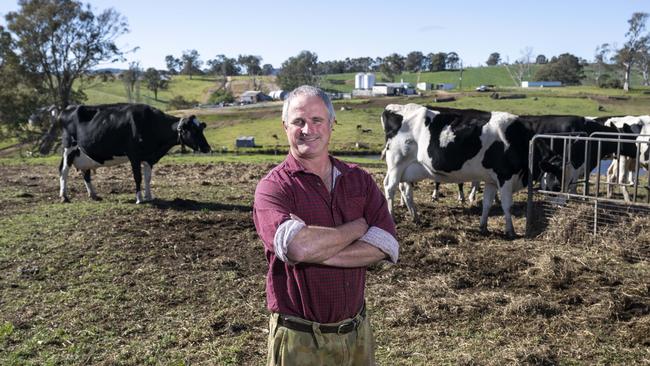Cheap milk days are over as inflation and property prices fuel a farming exodus
While the damage from the nearly decade-long $1 milk wars is coming back to bite grocery shoppers, farmers are being lured into selling their land as real estate for tree changers.

Record prices for land on the NSW coast are fuelling an exodus from the dairy industry as beleaguered farmers are lured into selling their agricultural land as real estate for sea changers amid rising business costs and inflationary pressures.
Current high prices for milk are in part because of historically low production in Australia driven by farmers leaving the dairy industry after years of fires, floods and drought and the damage wrought by the almost decade-long $1 milk wars between the major supermarket chains.
Registered dairy farms in NSW have halved since 2005, according to industry body Dairy Australia, falling from 1024 to 494 in 2022.
Dairy Australia industry insights and analysis manager John Droppert said some dairy farmers were switching to beef, others were amalgamating with larger companies and yet others were selling their farms.

Mr Droppert said a lot of traditional dairy country in NSW was along the coast and within proximity of cities like Sydney and Canberra, while industry deregulation in the early 2000s meant farms along the coast tended to be smaller than the national average.
“They actually convert quite readily into lifestyle blocks for people who might work in the city and want a weekender or want to live within commuting distance of urban jobs,” he said.
NSW Farmers policy director Nick Savage said urban expansion was creating conflict with existing dairy farms that tended to be concentrated on the coastal fringe, such as at Byron Bay on the north coast. “Local councils are increasingly ignoring agriculture in favour of urban expansion, and for dairy we’re seeing an acute impact,” he said.
NSW Farmers dairy committee vice-chair Malcolm Holm said the arrival of office workers to the regions meant dairy farms now had neighbours unfamiliar with the noise and odours of agricultural life. “All the little things … build up on those individual businesses and a lot of them say enough’s enough,” said Mr Holm, who also sits on the Australian Dairy Farmers National Council.
“We can have an easier lifestyle doing something else.”
PropTrack economic research director Cameron Kusher said there had been a massive surge in prices along the coast as city dwellers moved to the regions over Covid, including increases of more than 50 per cent on the Mid North Coast and the Shoalhaven and Capital regions on the south coast. “They’re nowhere near as cheap as they were before the pandemic,” said Mr Kushner, adding that prices were starting to fall.
Fifth-generation dairy farmer Phil Ryan, who has about 200 cows on his dairy farm in the Bega Valley, which includes south coast tourist towns Eden and Merimbula, said he was committed to the industry but he’d contemplated leaving during the drought in 2019 when his farm was just weeks away from running out of water.
“We’re struggling like everybody with escalating costs, things like electricity and fuel,” he said.
“We’ve also struggled a lot with fires, droughts and floods in recent years and that’s put a lot of stress on the industry.”
Dairy farmer Vanessa Todd, who operates a farm in Bodalla on the far south coast, is trying to convert to beef after floods and fires smashed an industry brought to its knees by pricing wars. “I’m trying to get out in a way that I get to maintain and keep my farm,” she said. “I have a real love-hate relationship with dairy – the last three years have been challenging.”
The cost of dairy and related products increased 15.1 per cent between March 2022 and March 2023, according to the monthly Consumer Price Index but Rabobank senior dairy analyst Michael Harvey said it was unlikely shoppers would be hit by another price hike any time soon. He said the milk pool had dwindled as more farmers exited the sector.
